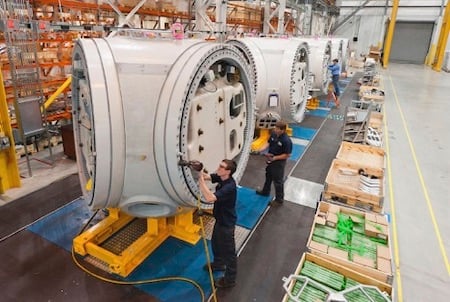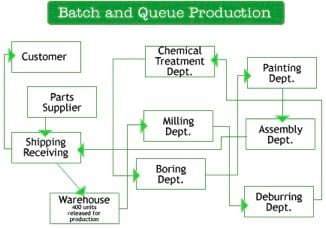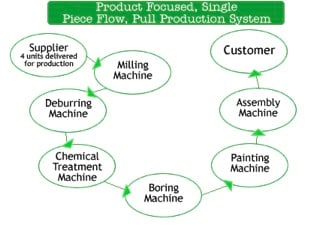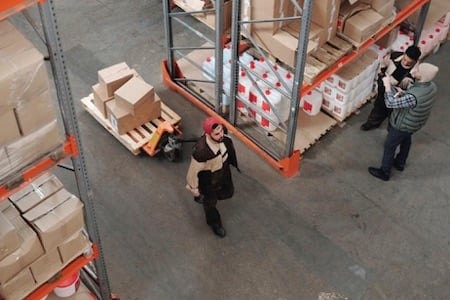Labor and material have to move around the factory floor to go through processes in the modern production floor. Production floor layout plays a crucial role in determining the production efficiency of the factory. When an inefficiency is observed, it cannot be overhauled without thinking through all of the consequences. Designing an optimal production layout must be done considering the long-term efficiency requirements to ensure optimized movement of labor and materials.

Production layout is critical in plants that involve large machinery that is difficult to move around. Image source: Kateryna Babaieva/pexels.com.
Challenges in Designing Production Layout
In today’s global supply chain, businesses have to be highly productive to stay relevant amid competition. The challenges arise from a turbulent trade environment, rising costs, and volatile market conditions. Supply chain efficiency has a sizable role to play in the success of a business. Increased production output due optimal production layout contributes to improve supply chain efficiency.
There are four major challenges in designing a production floor layout. They all pull in different directions.
- Economic operations of the plant
- Reliability of operations
- Reducing production time
- Flexibility
These four constraints are contradictory in nature. The most economic production layout is not the most reliable, flexible, or least time-consuming. When reliability and flexibility in operations are high, it is rarely economical. The challenge is to strike the balance between these opposing constraints. Reducing product life cycles and evolving demand make planning difficult. In such circumstances, flexible operations are difficult to achieve. Managing maintenance and repair operations in addition to these makes designing optimal production layout difficult.
Challenges from CAD Perspective
All modern organizations rely on CAD to build models before it is actualized. Designing a plant layout with the aim of optimization poses challenges, including:
- Internet of Things (IoT): Manufacturing facilities today rely on IoT devices to continuously collect and analyze data. This gives an edge to improve the plant operations while reducing costs. It connects various devices within the factory using machine-to-machine (M2M) communication, often over wireless networks. CAD is a potent tool to design layout and connections between physical objects. Though wireless communication connects various machines, those cannot be mapped using CAD. This makes designing IoT-enabled factories difficult with CAD.
- Robotic automation: Due to advances in automation, manufacturing facilities can employ flexible processes that can be programmed and changed with the push of a button. Designing layouts for such flexible automation projects are quite difficult with CAD and other design software.
- Lack of skilled labor: It is projected that 22% of skilled manufacturing labor amounting to 2.7 million workers will retire within the next 10 years. This will force organizations to redesign plant operations and layout. Designers will have to accommodate for a paradigm shift that is unprecedented and has limited experience with.
What is Cellular Manufacturing?
Cellular manufacturing is a methodology that emerged from the lean manufacturing philosophy. In this method, all the equipment and production modules are arranged in a sequence that mirrors the production process. This is to ensure the smooth flow of materials between workstations. This leads to minimal delay between processes for transportation and helps in improving production efficiency.

With cellular manufacturing, all the equipment and production modules are arranged in a sequence that mirrors the production process. Image source: Science in HD/unsplash.com.
In the traditional models of batch and queue production systems, various machines are fixed in place and the material to be worked on travels between these workstations. The machines will not be laid out in the same sequence as the operations taking place. Considerable time is wasted transporting materials between workstations multiple times.

In batch and queue production systems, material has to be transported long distances within the production facility as workstations are not laid out in the sequence of processes. Image source: epa.gov.
On the other hand, in cellular manufacturing the layout is process-based. The process that comes after the first process will be in the workstation right next to the first workstation. All the workstations are laid out in the same sequence as the production process. Very little time and energy are required to move materials and components from one workstation to the next.

In cellular manufacturing, the machines are placed in the same sequence as the production process. Image source: epa.gov.
Factory Layout Optimization
Designing optimal plant layout before implementation saves effort, capital, and time. An inefficient layout will continue to lose money for the company. It is better to redesign the production floor than to keep operating an inefficient factory and lose money.

Optimal production layout ensures weight movement of materials within the factory. Image source: Tiger Lily/pexels.com.
Each production facility will have the best layout specific to its processes. For example, in the manufacturing of airplanes, materials do not move from one station to the next. Instead, all the material is brought to one place where the aircraft is built. Apart from such niche instances cellular manufacturing is the ideal solution to building an economical, flexible, and reliable production layout.
In cellular manufacturing, two criteria are taken into consideration to create an optimal layout.
- Optimization of material flow direction
- Minimizing transport intensity
The best-case scenario is to design a production layout with a linear, unidirectional flow of materials. This eliminates the chances of bottlenecks and transportation blockages on the production floor. Similarly, the total transport intensity should be as little as possible. This reduces the time and energy expenditure for transportation. Total transport intensity is the product of material flow intensity and distance between workstations.
Last words
Designing or redesigning modern factory layouts is a challenging task due to evolving technology and global competition. These challenges are also reflected in CAD-based designs of production floor layouts. Cellular manufacturing is the methodology of laying out workstations in the same sequence as the production processes. Optimizing material flow and transport intensity during factory design using cellular manufacturing is an ideal solution in most instances and makes working with CAD easier.
***
Viewpoint articles are tech-focused editorial written by experts from the CAD industry. This article was written by Brian Christiansen from Limble CMMS.
Searching for more information about Product Design & Manufacturing?
Click here!
Brian Christiansen
Bryan Christiansen is the founder and CEO of Limble CMMS, a mobile CMMS (computerized maintenance management system) software that helps managers organize, automate, and streamline their maintenance operations.
View All Articles





Share This Post